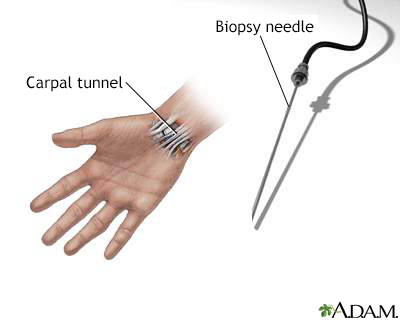Carpal tunnel biopsy
Biopsy - carpal tunnel
Carpal tunnel biopsy is a test in which a small piece of tissue is removed from the carpal tunnel (part of the wrist).

Carpal tunnel syndrome is becoming more frequently recognized and may be occurring more often. It may result from repetitive motion or the use of devices like computer keyboards. It affects the median nerve, the nerve that supplies feeling and movement to the thumb and thumb-side of the hand.

This picture shows the normal appearance of an adult's palm and fingers.

This picture shows a normal flexed hand. The tendons that move the fingers and are associated with carpal tunnel syndrome are visible just below the wrist.

Biopsy of the wrist and carpal structures.
How the Test is Performed
The skin of your wrist is cleansed and injected with medicine that numbs the area. Through a small cut, a sample of tissue is removed from the carpal tunnel. This is done by direct removal of tissue or by needle aspiration.
Sometimes this procedure is done at the same time as carpal tunnel release.
How to Prepare for the Test
Follow instructions for not eating or drinking anything for a few hours before the test.
How the Test will Feel
You may feel some stinging or burning when the numbing medicine is injected. You may also feel some pressure or tugging during the procedure. Afterward, the area may be tender or sore for a few days.
Why the Test is Performed
This test is often done to see if you have a condition called amyloidosis. It is not usually done to relieve carpal tunnel syndrome. However, a person with amyloidosis can have carpal tunnel syndrome.
Carpal tunnel syndrome is a condition in which there is excessive pressure on the median nerve. This is the nerve in the wrist that allows feeling and movement to parts of the hand. Carpal tunnel syndrome can lead to numbness, tingling, weakness, or muscle damage in the hand and fingers. Some of these injuries can be permanent, so it is important to have the condition addressed early.
Normal Results
No abnormal tissues are found.
What Abnormal Results Mean
An abnormal result means that you have amyloidosis. Other medical treatment and diagnostic tests will be needed for this condition.
Risks
Risks of this procedure include:
- Bleeding
- Damage to the nerve in this area
- Infection (a slight risk any time the skin is broken)
References
Buxbaum JN. The systemic amyloidosis. In: Hochberg MC, Gravallese EM, Smolen JS, van der Heijde D, Weinblatt ME, Weisman MH, eds. Rheumatology. 8th ed. Philadelphia, PA: Elsevier; 2023:chap 177.
Weller WJ, Calandruccio JH, Jobe MT. Compressive neuropathies of the hand, forearm, and elbow. In: Azar FM, Beaty JH, eds. Campbell's Operative Orthopaedics. 14th ed. Philadelphia, PA: Elsevier; 2021:chap 77.
Version Info
Last reviewed on: 8/27/2024
Reviewed by: C. Benjamin Ma, MD, Professor, Chief, Sports Medicine and Shoulder Service, UCSF Department of Orthopaedic Surgery, San Francisco, CA. Also reviewed by David C. Dugdale, MD, Medical Director, Brenda Conaway, Editorial Director, and the A.D.A.M. Editorial team.
